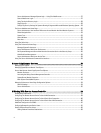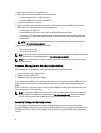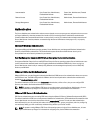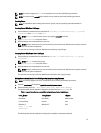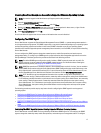
2
Setup And Administration
Dell OpenManage Server Administrator provides security through role- based access control (RBAC), authentication,
and encryption for both the Web-based and command line interfaces.
Role-Based Access Control
RBAC manages security by determining the operations that can be executed by persons in particular roles. Each user is
assigned one or more roles, and each role is assigned one or more privileges that are permitted to users in that role.
With RBAC, security administration corresponds closely to an organization's structure.
User Privileges
Server Administrator grants different access rights based on the user's assigned group privileges. The four user
privilege levels are: User, Power User, Administrator, and Elevated Administrator.
Table 2. User Privileges
User Privilege
Level
Access
Type
Description
View Manage
User Yes No
Users
can view most information.
Power User Yes Yes
Power Users
can set warning threshold values and configure
which alert actions are to be performed when a warning or failure
event occurs.
Administrator Yes Yes
Administrators
can configure and perform shutdown actions,
configure Auto Recovery actions in case a system has a non-
responsive operating system, and clear hardware, event, and
command logs. Administrators can also configure the system to
send e-mails.
Elevated
Administrator
(Linux only)
Yes Yes
Elevated Administrators
can view and manage information.
Privilege Levels to Access Server Administrator Services
The following table summarizes the users who have privileges to access and manage Server Administrator services.
Server Administrator grants read-only access to users logged in with User privileges, read and write access to users
logged in with Power User privileges, and read, write, and administrator access to users logged in with
Administrator
and
Elevated Administrator
privileges.
Table 3. Privileges Required To Manage Server Administrator Services
Service User Privilege Level Required
View Manage
12



